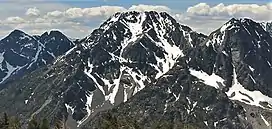Big Craggy Peak
Big Craggy Peak is a prominent 8,470-foot (2,580-metre) mountain summit located in western Okanogan County in Washington state, USA.[3] It is part of the Okanogan Range which is a sub-range of the North Cascades. This remote mountain is situated 12.5 mi (20.1 km) north-northeast of Mazama, on land administered by the Okanogan–Wenatchee National Forest. Big Craggy has two subsidiary peaks, North Peak (8,205-ft), and West Craggy (8,366-ft), the latter set on the Pasayten Wilderness boundary. The nearest higher peak is Monument Peak, 10 miles (16 km) to the west-northwest.[1] Big Craggy Peak ranks 61st on Washington's highest 100 peaks, and 62nd on the "Bulger List".[1] Precipitation runoff from Big Craggy drains into Eightmile Creek which is a tributary of the Chewuch River.
| Big Craggy Peak | |
|---|---|
 Big Craggy Peak seen from northeast | |
| Highest point | |
| Elevation | 8,470 ft (2,580 m)[1] |
| Prominence | 3,070 ft (940 m)[1] |
| Parent peak | Monument Peak (8,592 ft)[2] |
| Isolation | 10.05 mi (16.17 km)[2] |
| Listing | Highest Mountain Peaks in Washington |
| Coordinates | 48°45′47″N 120°19′41″W[1] |
| Geography | |
 Big Craggy Peak Location in Washington  Big Craggy Peak Big Craggy Peak (the United States) | |
| Location | |
| Parent range | Okanogan Range North Cascades Cascade Range |
| Topo map | USGS Billy Goat Mountain |
| Climbing | |
| Easiest route | class 2+ scrambling[2] |
Climate
Most weather fronts originate in the Pacific Ocean, and travel northeast toward the Cascade Mountains. As fronts approach the North Cascades, they are forced upward by the peaks of the Cascade Range, causing them to drop their moisture in the form of rain or snowfall onto the Cascades (Orographic lift). As a result, the west side of the North Cascades experiences high precipitation, especially during the winter months in the form of snowfall. During winter months, weather is usually cloudy, but, due to high pressure systems over the Pacific Ocean that intensify during summer months, there is often little or no cloud cover during the summer.[4]
Geology
The North Cascades features some of the most rugged topography in the Cascade Range with craggy peaks, spires, ridges, and deep glacial valleys. Geological events occurring many years ago created the diverse topography and drastic elevation changes over the Cascade Range leading to the various climate differences.
The history of the formation of the Cascade Mountains dates back millions of years ago to the late Eocene Epoch.[5] With the North American Plate overriding the Pacific Plate, episodes of volcanic igneous activity persisted.[5] In addition, small fragments of the oceanic and continental lithosphere called terranes created the North Cascades about 50 million years ago.[5]
During the Pleistocene period dating back over two million years ago, glaciation advancing and retreating repeatedly scoured the landscape leaving deposits of rock debris.[5] The "U"-shaped cross section of the river valleys are a result of recent glaciation. Uplift and faulting in combination with glaciation have been the dominant processes which have created the tall peaks and deep valleys of the North Cascades area.
See also
References
- "Big Craggy Peak, Washington". Peakbagger.com.
- "Big Craggy Peak - 8,470' WA". listsofjohn.com. Retrieved 2020-08-06.
- "Big Craggy Peak". Geographic Names Information System. United States Geological Survey, United States Department of the Interior. Retrieved 2020-08-06.
- Beckey, Fred W. Cascade Alpine Guide, Climbing and High Routes. Seattle, WA: Mountaineers Books, 2008.
- Kruckeberg, Arthur (1991). The Natural History of Puget Sound Country. University of Washington Press.
External links
- Weather forecast: Big Craggy Peak
- Big Craggy, West Face aerial photo: PBase
- Climbing information Big Craggy & West Craggy Peaks: Mountaineers.org